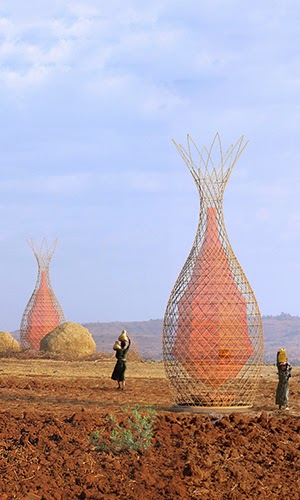 |
| image: Warka Water |
Kevin Samson
Activist Post
Fresh water supplies are under assault on multiple fronts. Front page news at the moment are the effects of the ongoing droughts in California and Brazil – both are incredibly important areas to the global food supply.
At the same time, corporate hoarding of fresh water is on the rise. At the heart of this initiative to make water a commodity is Nestle, whose former CEO clearly stated that water supplies should be privatized and that the right to fresh, clean water is not an essential human right. It becomes a dangerous possibility that companies such as Nestle would hoard supplies in order to artificially increase demand. Stephen Lendman succinctly states this when he calls Nestle a global water predator:
A January 2009 Food and Water Watch report was titled All Bottled Up: Nestle’s Pursuit of Community Water, saying: “Nestle takes water from US communities” on the cheap. It “bottles and sells it. (It does so) for billions of dollars in profit. (It) dumps the environmental and other costs onto society.”
It ignores community and citizen rights. It plunders for bottom line priorities. It bottles what’s no different from tap water. It sells it “for thousands of times more cost” than what most people in developed countries can get cheap or free.
Knowing that both the climate and corporate influence are converging to restrict and/or dramatically increase the cost of fresh water, are there any real solutions to this crisis? According to one inventor, the solution is very simple.
Some readers might be familiar with a product called EcoloBlue. This is an atmospheric water generator that pulls humidity from the air and filters the water to produce “free” drinkable water. Once the cost of the machine is offset, the cost of the electricity to power it would be the only expense. Definitely a savings over buying Nestle products, which Daisy Luther highlighted are subject to a 53 million percent mark-up!
But even the problems of localized drought and having to buy bottled water pale in comparison to what some regions of the world see as a permanent part of the landscape. And even here, Nestle is present to ensure a nearly full takeover of the water supplies in parts of South Africa, Ethiopia, and Pakistan. For these villagers, the hopelessness of life is ever present.
Inventor Arturo Vittorini, on the other hand, believes that a resource as vital as water should not be corralled, controlled, or corrupted by any corporation or government. In an effort to combat natural and artificial scarcity, he has designed towers that he is calling Warka Water.
 One of the prime challenges to providing true aid to remote regions is that an expensive infrastructure is often required for even the simplest solutions. Vittorini believes his towers have bypassed the traditional route of water infrastructure through the simplicity of harvesting water from the air itself. No searching for a water source, no drilling, no land rights issues, no need to battle corporate behemoths.
One of the prime challenges to providing true aid to remote regions is that an expensive infrastructure is often required for even the simplest solutions. Vittorini believes his towers have bypassed the traditional route of water infrastructure through the simplicity of harvesting water from the air itself. No searching for a water source, no drilling, no land rights issues, no need to battle corporate behemoths.
The towers are essentially EcoloBlue without the electrical power source.
Smithsonian.com provides the basic details:
At first glance, the 30-foot-tall, vase-shaped towers, named after a fig tree native to Ethiopia, have the look and feel of a showy art installation. But every detail, from carefully-placed curves to unique materials, has a functional purpose.
The rigid outer housing of each tower is comprised of lightweight and elastic juncus stalks, woven in a pattern that offers stability in the face of strong wind gusts while still allowing air to flow through. A mesh net made of nylon or polypropylene, which calls to mind a large Chinese lantern, hangs inside, collecting droplets of dew that form along the surface. As cold air condenses, the droplets roll down into a container at the bottom of the tower. The water in the container then passes through a tube that functions as a faucet, carrying the water to those waiting on the ground. (Source)
According the designers’ leaflet (PDF), Ethiopia will be the first test bed, as it has become a place where women and children have to walk hours per day just to find any water at all, and it’s very often contaminated. The specs for assembly are simple, easy to transport and fast to assemble.
Transport: 2 donkeys
Location: Ethiopia, Africa
Assembly: 3 days, 6 people
Structure: Modular lattice framework
Energy: Solar panel for illumination
Materials: Bamboo or similar local material, rope, wire, PE-fabric
Dimensions: dia 8 m, h 9 m
Weight: 40 k
Cost: $500
The tower is assembled in sections and installed from top down. The structure can be lifted and fixed to the ground by 4 men, no scaffolding needed. The fabric can be lowered for maintenance.
[…]
The material used for the structure is the locally sourced giunco, iron wire for the connections and polyethylene textile for the fog harvesting.
 Early prototypes have been built with a goal of providing 25 gallons of water each throughout the day. Investors are being sought for possible mass production, but the designers stress that the low cost of training and maintenance could give the towers a life of their own in the region as villagers begin to share their new-found knowledge with others.
Early prototypes have been built with a goal of providing 25 gallons of water each throughout the day. Investors are being sought for possible mass production, but the designers stress that the low cost of training and maintenance could give the towers a life of their own in the region as villagers begin to share their new-found knowledge with others.
“It’s not just illnesses that we’re trying to address. Many Ethiopian children from rural villages spend several hours every day to fetch water, time they could invest for more productive activities and education,” he says. “If we can give people something that lets them be more independent, they can free themselves from this cycle.”
Water scarcity is an alarming prospect for all of us. The extended droughts, cumulative aspects of general human pollution, dirty industrial and agricultural practices, blatant chemical contamination and ruthless corporate hoarding are becoming borderless problems that we all are likely to face in the coming decades. This new invention very well could put everyone on a path to water independence – one of the foundations of a prosperous, healthy society.
We’ll be keeping an eye on the implementation of this product and other similar projects and will issue updates as they become available. In the meantime, you can visit the Warka Water website here for additional details and updates.
You can view their video below. If you cannot view it on our site, the original source can be found here.
Related:
Great Lakes Water To Be Sold To China As Half The U.S. Faces Extreme Water Crisis
Recently by Kevin Samson:


Be the first to comment on "Is This New Device a Solution for Free Clean Drinking Water?"